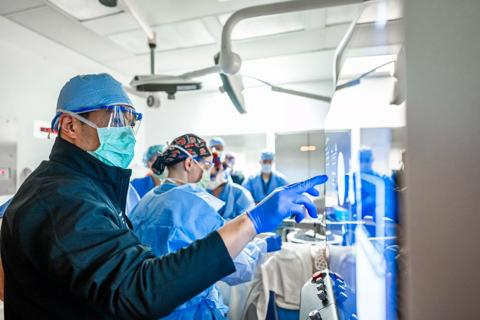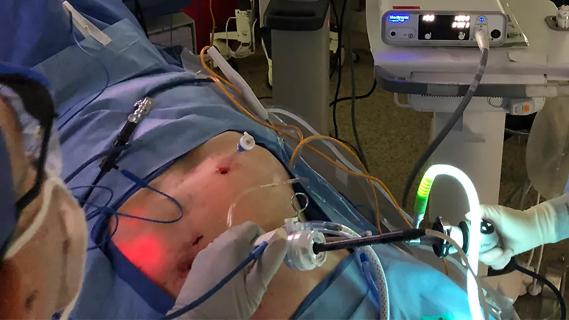IBAT inhibitors, elastography and more

In the last decade, the childhood obesity epidemic has dramatically increased the number of children with metabolic-associated fatty liver disease (MAFLD), now estimated at 5% to 10% of kids in the U.S.
Advertisement
Cleveland Clinic is a non-profit academic medical center. Advertising on our site helps support our mission. We do not endorse non-Cleveland Clinic products or services. Policy
“Often people don’t perceive that liver disease happens in children or that it can be very serious,” says Karen Murray, MD, Chair of Cleveland Clinic’s Department of Pediatric Medical Specialties. “In fact, about 20% of kids with fatty liver disease will advance to cirrhosis and need a transplant.”
Also increasing are liver diseases associated with previously fatal conditions that children are now surviving, such as cystic fibrosis and univentricular heart, as well as autoimmune conditions of the liver.
Cleveland Clinic Children’s team of five pediatric hepatologists manages the care of children with these and other liver conditions.
“Our goal is to keep our patients as functional as possible, using leading-edge treatments to enable our patients to live with the liver they have,” says Vera Hupertz, MD, Medical Director of Pediatric Hepatology. “But if they do end up needing a transplant, we’re ready to care for them before, during and after, until they’re ready to be followed by our adult hepatology team. Children deserve to live their best life to the fullest, and our pediatric team is here to ensure all children in need can thrive.”
The pediatric hepatology team has incorporated several innovative approaches to patient care, including:
Ileal bile acid transporter (IBAT) inhibitors, regarded as one of the most transformative innovations in pediatric hepatology, reduce excess serum bile salt accumulating in the skin and eliminate or decrease the debilitating pruritus common in progressive familial intrahepatic cholestasis (PFIC) and Alagille syndrome, based on preliminary studies.
Advertisement
Dr. Murray conducted some of the early IBAT trials before she joined Cleveland Clinic. More recently, Dr. Hupertz has served as an investigator for trials of the IBAT maralixibat, now approved in the U.S. for treating cholestatic pruritus in patients age 5 and older with PFIC and in patients age 3 months and older with Alagille syndrome.
“IBATs are true breakthroughs for kids with these conditions,” Dr. Murray says. “The pruritus can be debilitating, and at times the scratching can be disfiguring. When children have pruritus from cholestasis, as occurs commonly in these conditions, the quality of life for the child and the entire family is degraded. These children don’t sleep well or perform well in school, and their social interactions can be affected because the kids are itchy all the time. IBAT inhibitors have squelched those symptoms. They’re incredibly impactful.”
Formerly called “nonalcoholic fatty liver disease,” MAFLD is increasingly seen in children who are overweight or have obesity. While there is currently no approved medication treatment for the condition, weight loss is effective. Cleveland Clinic Children’s addresses treatment in two ways.
One is with the multidisciplinary Be Well Kids Clinic that brings together a comprehensive team of physicians, researchers and other healthcare professionals with expert knowledge in childhood obesity to help children ages 2-18 and their families develop strategies for lifestyle change. Hepatologists are among the professionals collaborating in that effort.
Advertisement
In addition, the hepatology team is now extensively using noninvasive elastography to assess liver stiffness in patients with MAFLD to determine which patients are at greatest risk for liver scarring.
“Progressive scarring can lead to cirrhosis and a need for transplant,” Dr. Hupertz says. “We try to intervene early with a multidisciplinary team of dietitians, exercise specialists, social workers and psychologists to slow the progression often associated with continued rapid weight gain.”
Cleveland Clinic is a world-renowned center for Fontan procedures in infants born with a univentricular heart. The procedure reroutes oxygen-poor blood straight to the pulmonary artery, bypassing the heart chambers. One ramification, however, is permanently elevated central venous pressure, which can lead to congestive hepatopathy, liver fibrosis and cirrhosis, and even hepatocellular carcinoma.
Hepatologists at Cleveland Clinic Children’s work with cardiologists, nephrologists and other specialists to care for patients with Fontan-associated liver disease, typically in combined clinic visits. This coordinated care is more convenient for patients and their families, helping them avoid attending multiple appointments.
Pediatric hepatologists also are part of the caregiver team in Cleveland Clinic Children’s Cystic Fibrosis Program. Often regarded as a lung disease, cystic fibrosis can damage other organs, including the liver. Between 5% and 10% of patients with cystic fibrosis will develop cirrhosis.
Advertisement
Dr. Murray has led several studies in this area, particularly on the use of ultrasound and other imaging to detect liver complications in these patients and identify early those at risk for advancing liver disease.
“Based on this research, we also now better understand the factors that correlate with the development of liver disease, and the risks and benefits of liver transplantation for children with cystic fibrosis,” she says.
Led by pediatric hepatologist Kadakkal Radhakrishnan, MD, the Glycogen Storage Disease Program at Cleveland Clinic Children’s is one of few in the U.S. and among the largest. The program treats children with any of the eight forms of the rare, liver-related genetic disease that causes hypoglycemia, muscle weakness and liver damage.
The program offers patients the latest gene and dietary therapies, as well as opportunities to participate in clinical trials.
The combination of all these services helps Cleveland Clinic Children’s hepatology team care for patients with even the most complex liver conditions.
“With early diagnosis and better control of their disease activity, patients with any of these disorders may live healthier and longer with the liver with which they were born,” Dr. Hupertz says. “Our goal is to enable children with liver disease to thrive without complications, but when complications develop, our team is here for them and is able to provide any level of care they need.”
Advertisement
Advertisement

Study reveals key differences between antibiotics, but treatment decisions should still consider patient factors

Findings could help clinicians make more informed decisions about medication recommendations

The SPECCIAL study is the first to examine long-term clinical outcomes

Findings also indicate reduced risk of serious liver events

Findings are first to provide underlying explanation, linking the diagnosis to high-immune activation and worse clinical outcomes

Histotripsy is noninvasive and may generate abscopal effect

New device offers greater tumor control for malignant liver lesions

Reviewing how the drug can be incorporated into care